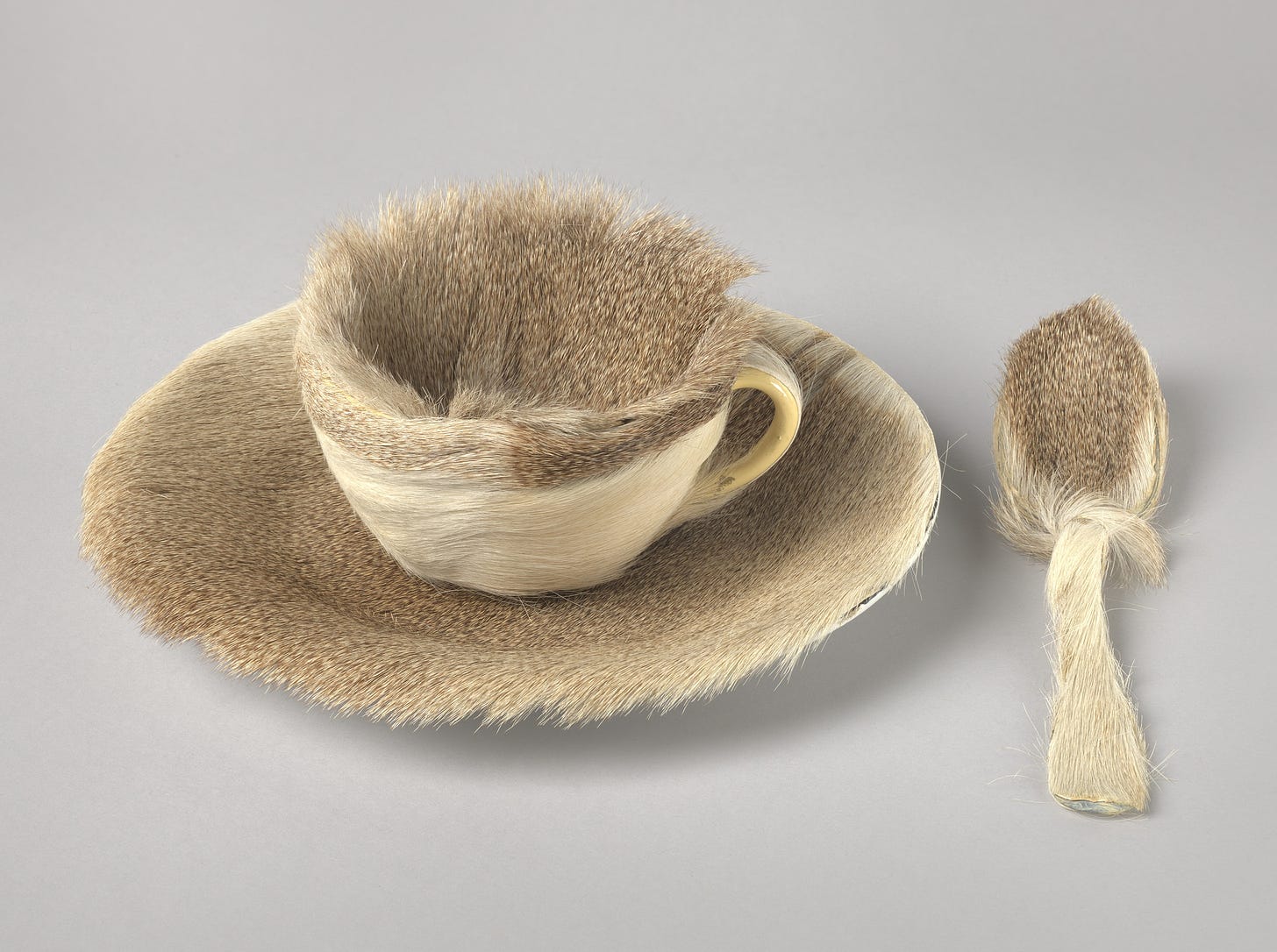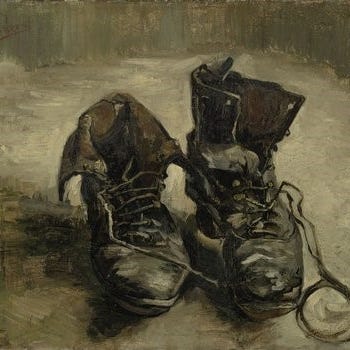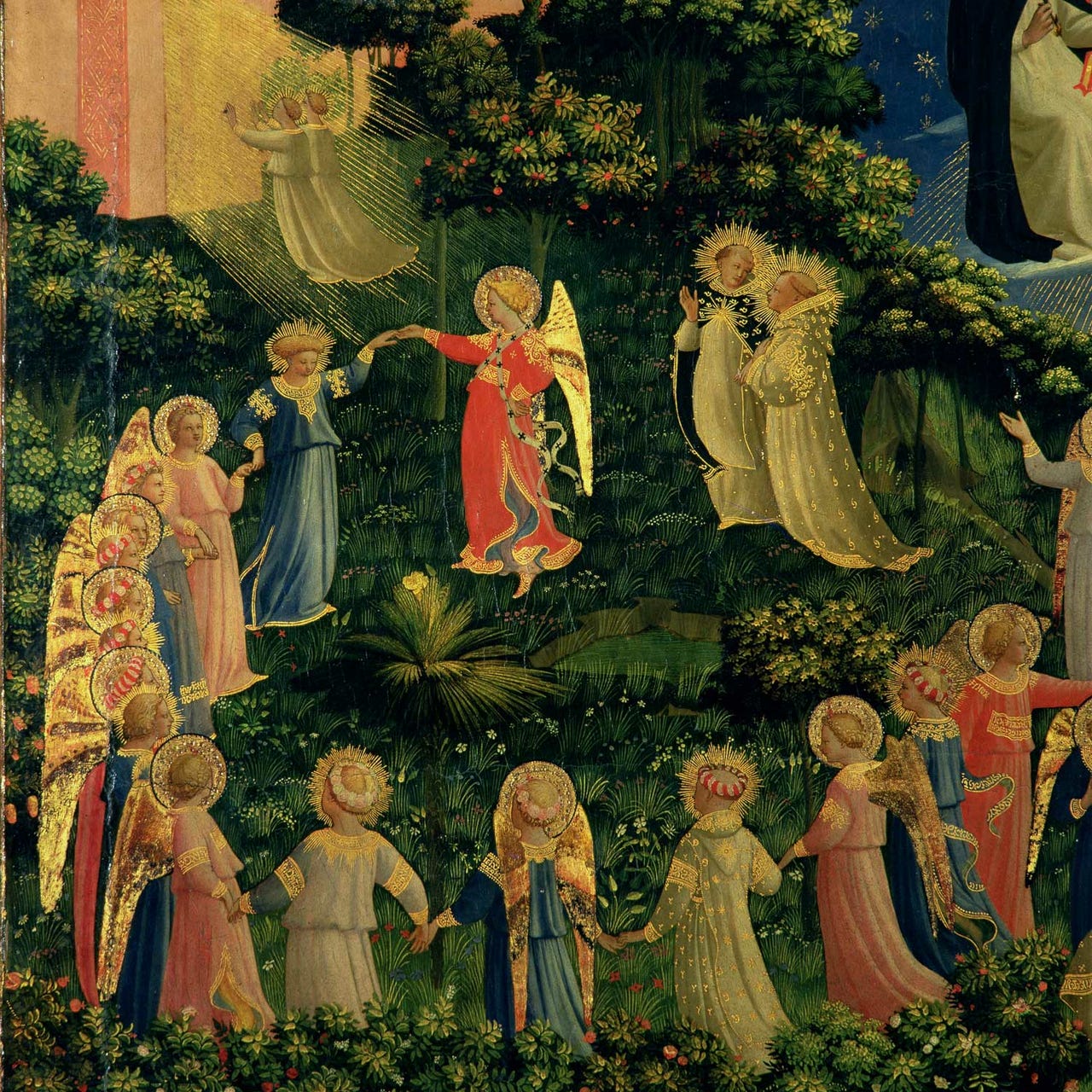Meaning Outside Ourselves
Beautiful Art, The Doctrine of Creation, & A Tea Cup Covered in Fur
Beauty reminds us that we are more than mere matter and that we long for meaning from outside ourselves. And that is why modernity hates it. —Dean Abbot
They say life imitates art. When understood rightly, they are right. And when I say “understood rightly”, I mean completely differently than the way Oscar Wilde intended. “Life imitates art” to Oscar Wilde was about our desire to create meaning. But to us, “Life imitates art” means that Life and Art are brothers with a common Source. It is a confession of the doctrine of Creation.
Creatorem Caeli et Terrae
I believe in God, the Father Almighty, Maker of heaven and earth…
If we are living in Creation, then God is the Artist and the Author of life. Life imitates art because all of Creation is art from the mind of God. The Artist likes symmetry, harmony, and repetition: the shape of the wispy clouds looks just like the ridges in the sand after a gentle wave. That cute girl’s freckles look like a starry night. The One who drew the circle of the cosmos crouched down to draw with His finger in the dirt. Beauty is in Creation, and Beauty is in Redemption. He who made the expanse of the heavens contracted to a span in the womb of Mary. He who made all things is making all things new.
The appreciation of art is merely an entering into this Beauty. It is a transcendent experience. But an atheist believes that “transcendent experience” is a delusion. It is a trifle and a deception if there is no Maker. If we are moist robots, here by chance, copulating as an accident of our chemistry, as the materialists claim, then the experience of transcendence is just a signal from your overdeveloped primate nervous system that arrived by mutation. Do you see some sort of beauty in Michelangelo’s Pieta? That is because of a series of genetic mutations. Do you find the resolution of a fat E7 Chord back to an A7 in a blues shuffle liberating? Well, somehow that is because the slow march of time determined that a nice musical harmony would help you regulate your violent tendencies, and maybe get your genes to make it a few more generations, you confused ape.
Those last few sentences were not only unpleasant to write, but I could not even write them convincingly due to the vacuity of the worldview satirized. No man is a full adherent to that worldview, or he ceases to be a man. To be human involves an appreciation and knowledge of goodness, truth, and beauty that can only be described as transcendent.
“But”, a hypothetical interlocutor may say, “there is evil, lies, and ugliness in the world! Some people like these evil and ugly things. So, what of your man-as-transcendent-art-critic now?” A great question, my imaginary conversationalist. The desire we see in some for evil and ugliness is further proof of the Christian doctrines of Creation, the Fall, and Redemption. Evil, lies, and ugliness do not have ultimate existence, they are contingent on better things. Lies can hardly be said to exist, it is more like there is a malice that intentionally distorts the truth. God is ultimate goodness: evil is the rejection of that goodness. So when someone is attracted to the opposite of the transcendentals, it is precisely because he knows that they are transcendental. He likes to not like them.
Good Art, Bad Art
Let’s zoom back in on our discussion of Art and Beauty. What makes good art? As with all profound questions, a little child knows the answer but we could still write hundreds of true books answering it. Beautiful art reminds us that we are contingent. It reminds us that we are not the primary cause. We are not the center of the cosmos. “Meaning outside yourself exists”, says good art. It raises our contemplation to our Creator. It raises us to recognize and recieve the Love of the Artist, who said, “When I am raised up, I will draw all men to me.”1 The medieval painter Fra Angelico would be drawn into that Love, and whenever he painted a crucifixion, he would weep.
There are four types of art. First, there is art that believes in meaning outside ourselves and is skillfully done. This is good Good art. Second, there is art that believes in meaning outside ourselves, and is poorly done. This is bad Good art. Third, there is art that denies meaning outside ourselves, but despite itself, is skillfully done. This is good Bad art. Lastly, there is art that denies meaning outside ourselves and is poorly done. That is bad Bad art.
So we have good Good, bad Good, good Bad, and bad Bad art.
The worst modern art is not the worst because it uses colored rectangles instead of classical perspective. It is the worst becasue it is bad Bad art from my above ramblings. There is absolutely a Good, True, and Beautiful way to do ‘modern’ art. We will often use ‘modern’ as a shorthand to describe the godless worldview we see in some modern art. Many recent artists are still Good.
What makes the worst of modern art the worst is rooted in falsehood. Lies are a falsehood, Evil is a falsehood. Ugliness is a falsehood. Art at its best is very transcendental, even in simple subjects like a still life. A good still life brings glory to the Creator. Art at its worst denies our dependence on the Divine.
An angel that gets too big for his britches and says, “I’m not a commander of an angelic unit of ten, I’m a commander of a hundred!” has erred, but he has not committed the worst error. The angel that says, “I will never be ruled”, has erred cosmically. The art that says, “Look, here’s some chaos!” may have erred in some respects, but it has also said many true things, in some level of obedience to the Logos. But the art that claims the name, “art”, but then whispers, “There is no transcendence. You don’t need to look outward to God”; that art has taken up the voice of the serpent, and has chosen the outer darkness, where there is weeping and gnashing of teeth.
This is the progression of evil in many respects. With the sin of lust, a young man is infatuated with the sight of an immodest swimsuit model, but decades down the line, even that which was according to nature in his desire has vanished. The beauty of the feminine form has been discarded, and heinous perversions are the only way to reach a high. Serial killers all start as porn addicts. Natural desires are no longer enough. Ugliness and death no longer are a consequence of the sin, they become part of the sin. They have hardened their hearts to goodness, truth, and beauty.
Art has done this very thing to itself. Our first reaction to many modern artists is, “What’s the point? It’s not about anything, and it doesn’t look good!” That, my friend, is the point. It is not about anything. It has no local telos because it has denied telos in the cosmos. It hates goodness. Beauty is a sort of evangelist, and we know how the world received the first evangelists appointed by our Lord.
A Fur Covered Tea Cup
Maybe I just don’t get surrealism. But I am going to criticize Le Déjeuner en fourrure, "The Luncheon in Fur", anyway. It is a good stand-in for the sort of art that the establishment likes today. Some of the art at the elite art institutions today is so heinous that I could be guilty of sin if I were to put it before your eyes, so this cup is a stand-in for all that.
Good art should sometimes unsettle us: I think of some of the more intense Crucifixions I have seen or even something more modern like Picasso’s Guernica. Good art can bring about melancholic feelings like loneliness or sorrow, or incite a righteous indignation towards the unjust actions of the wicked. Those negative emotions are connected to the fear of God.
But Luncheon in Fur is disturbing the way a demonic nightmare is disturbing. It is a rejection of the transcendentals. It is not a wake-up call, showing the badness of the bad for the purpose of reforming the viewer. It is showing the badness of the bad, and the ugliness of the ugly, not for us to change, but for us to be desensitized. It disturbs, not to bring about repentance, but to bring about hardness of heart. It is an invitation to apostatize.
It is an invitation to see something that we know is not Normal, then to remember the Normal, and then to hate it, and then to deny that Normal even exists. It is a rejection of Goodness qua Goodness. There is a rejection of the goodness of the marriage bed, of fertility, of children. There is a rejection of hearth, home, nation, and virtue, hot tears, and hearty laughs. There is a rejection of the gifts because they call to mind the Giver.
Do You Believe in Normal?
In C.S. Lewis's incredible book, That Hideous Strength2, one of our protagonists Mark is uncovering the evil of the N.I.C.E, a quasi-governmental organization set on power and ‘progress.’ He has been brought into the orbit of the leaders of this scientific organization, and longs for their approval; he longs for membership in the inner circle. Mark has some reservations about these men, but they offer him initiation into the occult inner circle, not immediately by anything plainly demonic, but by a room, where everything is slightly off.
There is a painting of a young woman holding her mouth wide open to reveal that the inside of it was thickly overgrown with hair. It was very skillfully painted in the photographic manner so that you could almost feel that hair; indeed you could not avoid feeling it however hard you tried.—That Hideous Strength, C.S. Lewis
The Objective Room3 meters out just enough disturbing forms to unsettle, and to desensitize.
“The room itself is a little bit off—too high and narrow, with an arch over the door that is slightly off-center, just enough to bother and unsettle the mind. The ceiling and table are both covered with spots, arranged to suggest regularity and pattern, but always frustrating the expectation once aroused.” —That Hideous Strength, C.S. Lewis
The point of time in the Objective Room is to make Mark more susceptible to the demonic initiations to come. He is meant to become desensitized to these abnormal things. So first, it is to deny Normal. This is the common-grace goodness that God shows to the just and the unjust. Then, to deny Goodness, Truth, and Beauty.
This is the same purpose of much modern art, whether intentional or unintentional. It would be lacking some nuance to say that “Modern art makes you more likely to get demonically possessed.” But that statement lacks just a little nuance, not much. This is also the purpose of a certain type of modern entertainment, commercials, and popular music.4 The kingdom of darkness wants to deny Christ, the eternal Word. They have felt the fundamental Love that turns the spheres, and have rejected Him.
Following the Objective Room, Mark is told to step on a crucifix. This may seem like quite a far jump from just weird art, but Lewis is making the point that these two things are not as disconnected as they at first may seem. But Mark refuses, and instead of blaspheming our Lord, he takes his first step of faith in the living God, by an act of the will, believing in the Normal: in the doctrine of Creation and Creator. He was given grace to see evil for what it really is.
“As the desert first teaches men to love water, or as absence first reveals affection, there rose up against this background of the sour and the crooked some kind of vision of the sweet and the straight. Something else—something he vaguely called the “Normal”—apparently existed. He had never thought about it before. But there it was—solid, massive, with a shape of its own, almost like something you could touch, or eat, or fall in love with.” —That Hideous Strength, C.S. Lewis
One Thing Have I Asked
That is always the danger that the kingdom of darkness runs. When devils start showing their true colors, the sons of Adam might come to thier senses. Ugly art might desensitize, yes. But it might also make a prodigal son go home. It might cause a man to implode, and become a den for demons, or it might cause him to realize that there is meaning outside himself; there is Reason, and He is a Person; there is Beauty, and He is the Image of the Invisible God, and invites us into that beauty. The Beauty of the Father's house is such we can say with king David,
“One thing have I asked of the Lord, that will I seek after: that I may dwell in the house of the Lord all the days of my life, to gaze upon the beauty of the Lord and to inquire in his temple.”5
Eternal beauty is the inheritance of the sons of God. Good art reminds us to hold our original confidence firm to the end,6 that we may aquire possession of it. In that day, there will be no more need for paintings, and sculptures, and images. Right now we see as in a glass, darkly; but then, face to Face.
Come, Lord Jesus.
Thank you for reading Power & Glory. If you enjoyed this post, check out these other two Substack publications. They share and discuss good Good art with a high level of excellence.
John 12:32
See this article on how the gender dysphoria in media relates to the Objective Room.
This video, “Ever Noticed How "Weird" Modern TV and Film are?” has some more thoughts on this.
Psalm 27:4
Hebrews 3:14









I was in NYC a while ago when the bienniale was happening at the Whitney. My family was there from out of town and so we went. Why miss out on an important show?
The art was dreary and unmemorable. What was memorable was how many of the artists wrote thar they were trying to capture how banale life is.
Banale? Life is too short! It wasn't just one or two artists, either. Imagine being so uncreative. It was more humorous than baffling. "Okay, artists, now go back to your cheez-its and government stipend." Not that I have anything against cheez-its.
This is eminent. I enjoyed reading it.